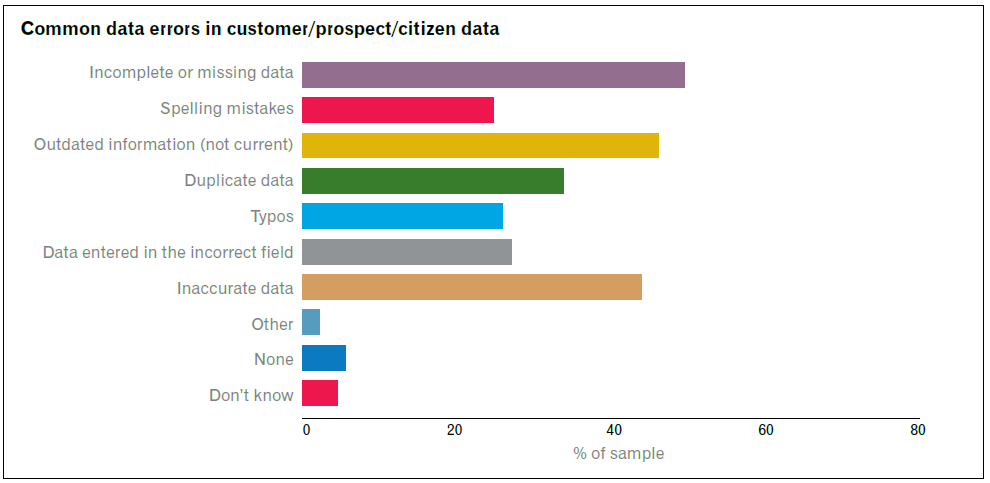
Step 1: Step up the quality of your data
“The surest way to torpedo a BI initiative is to have it serve up data that looks obviously wrong or that doesn’t stand up to closer scrutiny by people who know better” – Gleanster, Gleansight Benchmark Report on Business Intelligence
The major selling point of Business Intelligence (BI) solutions is their ability to consolidate all the available data about your business. Most people would agree that it makes it easier to do analysis on consolidated data and in turn, helps to make more informed and educated decisions.
But what do you do if that data is terrible?
A general distrust of new systems is a huge obstacle to their implementation and success. When companies put in a CRM they want to hold on to their spreadsheets and pre-CRM databases and stay in their comfort zone, and the same holds true for BI.
Your goal is to get them over that initial mistrust and convert them into willing and able users of the BI solution, and that goal is achieved with clean and trustworthy data. If users start to doubt the accuracy of the information in the system, winning back their trust is a nearly insurmountable task. This is especially true if they have been burned in the past by other similar programs.
So what can you do to clean up your data? Start by looking for the 5 most common errors in customer/prospect data:

The cleaner your data, the more insights your team will be able to draw from your systems. The more insights they draw, the more they’ll find value in your BI solution. Helping your team find this value should be a top priority if you want them to use the system.
Step 2: Work with executives to make BI a part of your company culture
“As with any technology intended for broad development, it helps to have a push from the top that says ‘This is how we’re going to do business’.” – Gleanster
Two key elements of creating a BI culture are communication and effectively managing resistance to change:
- Communication: BI implementations affect the entire business, from the top down. As with any big organisational change, you need to make sure you are communicating the importance of BI to your executive team (Directors, Owners, Senior Partners, etc.) as well as your user base. For many, this requires a change in the way they make business decisions.
- Resistance to change: You’ll need to be prepared to run into resistance. Managers who were successful before data-based decisions became the norm, those who relied on gut instinct, may be resistant to the shift in thinking. Gleanster recommends celebrating decisions that are supported by hard data and discouraging those that run contrary to data or are made without consulting it.
Your leaders need to be committed to data-based decision making. If they are on board, anyone who wants to be a high performer in your business has no incentive but to be on board as well.
In a recent webinar about democratising analytics, panellist Trevor Attridge, Global Director of Data and Technology at ad agency MEC, recommended getting your organisation past the “culture of fear”. Make people comfortable that data won’t be replacing them or stealing their jobs so they won’t be tempted to manipulate the data to make their departments or themselves look better. You should aim for making your culture of data-driven decisions the destination of a journey that your company will all go on together.
The key to a successful BI initiative is user adoption, and that adoption can only come about through reducing anxiety and building trust in the system.
Step 3: Deliver contextual training to build user confidence
“Formal training sessions may or may not be efficient or effective…employee learning styles will dictate whether training should be in person, online, instructor led or self-guided” – Gleanster
Offering training on your BI solutions to your users is perhaps the most obvious way of increasing user adoption, but it’s not necessarily the most straightforward. When you plan your training program, there are some things to keep in mind.
First, it is important to accurately gauge your staff’s analytic skill level. Some obstacles that you may need to overcome include:
- Level of computer literacy
- Time, willingness and ability of employees to add data to the system
- Employee learning styles
- Access to computers (in the cases of users like field workers)
Once you know how proficient your user base is with the technology, you can begin to plan a training program that fits those specific needs.
One thing you should strive for when educating users is contextual training – making sure that the training is specific to your company. As we’ve mentioned before, by learning not only how to use the features and functions of your chosen BI solution, but learning how to use it in your organisation you will have a better chance at getting users to use and rely on the system for data-driven decisions and business improvements.
This contextual understanding, according to Gleanster, is critical if line employees are going to learn how to frame hypotheses that can be tested on the BI system rather than passing all their questions to company analysts or ignoring the questions entirely.
By helping users understand the system in the context of their own jobs, you will be more likely to see great insights that encourage users to use the system even more.
Step 4: Measure your progress and celebrate your successes
“BI Top Performers are 3 times more likely than Everyone Else to measure BI software utilisation among individuals who have licenced access.” – Gleanster
How can you know how the user adoption on your system is going unless you measure it?
Make sure that you are taking steps to determine whether employees are using the system at the frequency you were anticipating. Here are some user adoption KPIs you should be monitoring, especially after users have been fully (and contextually!) trained on your solution:
- Number of active users
- System usage numbers (e.g., number of queries, dashboard views, etc.)
- Number of users receiving reports
- Number of reports generated
In addition to usage numbers, you may want to consider some of these metrics for measuring ROI of your BI system to determine how well your initiative is going:
- Financial metrics (revenue, margins, etc.)
- Employee productivity/performance
- Operating margins
- Total cost of ownership (short-term fees and long-term expenses)
Establish your company’s KPIs early on so you can celebrate success and milestones when you reach them. You’ll also know if your initiative is on track or if there are additional actions you need to take to make your project profitable and beneficial to your business such as further training, cleaner data, etc.
We alluded to this a bit in Step 2 with the executives. It is important in the early stages of a BI initiative to acknowledge and celebrate decisions and insights that are supported by hard data. Celebrating these successes created a feedback loop of positive reinforcement around the solution. The more you celebrate insights, the more encouraged others are to find insights that can be celebrated, and so on, around and around.
As a final note, don’t just rely on the numbers to gauge the success of your project, be sure to check in with key users to see if they need any additional training or resources and ask how satisfied they are with the BI tools. The more insight you have about the human side of your BI initiative, the more control you have over increasing user adoption.
Conclusion
BI user adoption is one of the key indicators of a successful BI project. By taking steps to maximise user adoption, you are taking steps to increase the ROI of your new system. Whether you’re in the middle of your BI implementation or if you are still in early stages, it’s not too late to put these steps into practice.
- Improve your data quality to build trust in the system
- Work with the executive team to build a culture of data-driven decision making
- Deliver training tailored to your team and your business
- Celebrate all the successes of your BI system to create a feedback loop of positive change
Researching your BI project? Make sure to ask these 5 questions before you buy.


